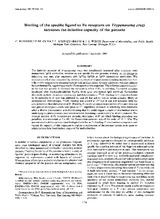Mostrar el registro sencillo del ítem
Binding of the specific ligand to Fc receptors on Trypasonoma cruzi increases the infective capacity of the parasite
| dc.contributor.author | Rodríguez de Cuna, C | |
| dc.contributor.author | Kierszenbaum, F | |
| dc.contributor.author | Wirth, JJ | |
| dc.date.accessioned | 2017-09-07T15:20:48Z | |
| dc.date.available | 2017-09-07T15:20:48Z | |
| dc.date.issued | 1991 | |
| dc.identifier.uri | http://repositorio.umsa.bo/xmlui/handle/123456789/12388 | |
| dc.description.abstract | Summary. The infective capacity of Trypanosoma cruzi was significantly increased after treatment with monoclonal IgG1 antibodies, whether or not specific for the parasite; minimal or no change in infectivity was seen after treatment with IgG2a, IgG2b or IgG3 monoclonal antibodies. The stimulatory effect was evidenced by elevated numbers of trypanosomes invading mammalian host cells in vitro compared to parasites treated with medium alone. Greater infectivity was also induced by pure human Fc, suggesting a role for Fc receptors on the organism. This inference received support in the fact that protein A inhibite4d the stimulatory effect of Fc In addition, Fc-treated parasites incubated with fluorescein- labelled F(ab’)₂ from goat anti-human IgG exhibited fluorescence detectable by both ultraviolet microscopy and flow cytometry. 12⁵I-Fc binding to T. cruzi was found to be saturable at 0° and was inhibited by cold Fc but not by bovine serum albumin (BSA) or orosomucoid. Interestingly 12⁵I-Fc binding was greater at 37° and it was not saturable with the concentrations that dis saturate at 0°.Possibly, Fc might up-regulate expression of its own receptor and greater endocytosis could take place at 37°. Significant increases in infecivity were detectable after a 40 min pretreatment with Fc—hinting that Fc could trigger a chain of biochemical events… | es_ES |
| dc.language.iso | en | es_ES |
| dc.publisher | Immunology | es_ES |
| dc.subject | RECEPTORES Fc | es_ES |
| dc.subject | TRYPANOSOMA CRUZI | es_ES |
| dc.subject | PARÁSITOS | es_ES |
| dc.title | Binding of the specific ligand to Fc receptors on Trypasonoma cruzi increases the infective capacity of the parasite | es_ES |
| dc.type | Article | es_ES |

